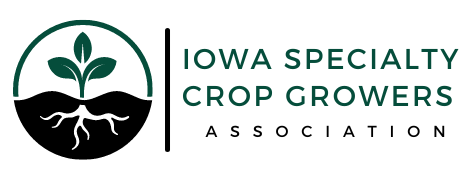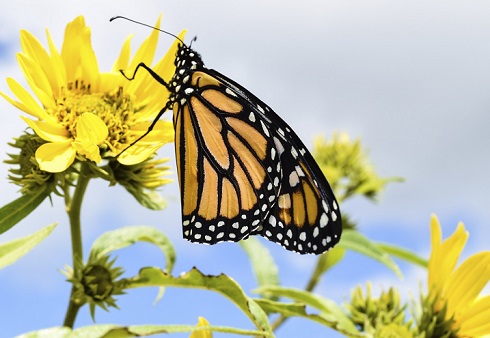Joe Hannan
Commercial Horticultural Field Specialist
Iowa State University Extension and Outreach
jmhannan@iastate.edu
Rainwater as an irrigation source is continuing to grow in popularity across Iowa. Since Shawn Shouse and Linda Naeve of Iowa State University designed their first high tunnel catchment system in 2010, the system designs and intricacies have expanded to ever-larger volumes of water collected, collection from other buildings, and diverter systems for cleaning physical debris prior to water storage. We have also had the implementation of the Food Safety Modernization Act (FSMA) Produce Safety Rule (though Subpart E – Agricultural Water is delayed until 2022) which provides guidance on managing microbial risks in water.
While we do not normally think of water in Iowa as a limiting factor for the production of fruits and vegetables, the quality and availability can sometimes be less than desired. Iowa is not the land of 10,000 lakes and what surface water we do have is often murky, contains organic matter and other particulates, as well as human pathogens. Effectively using surface water sources for irrigation requires filters to remove organic matter and particulates as well as managing the risk of human pathogens. Ground water in Iowa is often deep and prohibitively expensive if a new private well is needed and rural water can get expensive during dry years. Regardless of owning a well or purchasing water, Iowa’s deep groundwater contains calcium and magnesium that clogs irrigation emitters and increases soil pH beyond crop acceptable levels. This requires frequent monitoring of irrigation lines to ensure they are working and supplemental sulfur applications to the soil to help hold the soil pH down or acidification of the irrigation water.
While Iowa may not be the land of 10,000 lakes like our neighbors to the north, it could be the land of 10,000 tanks. Rainwater catchment systems can be installed anywhere gutters can be installed to divert water flow into a tank such as high tunnels, machines sheds, or houses. These systems are installed for a fraction of the cost of a new deep well. A 3,000 gallon water tank can be purchased for $1500 and a 1 hp pump for as little as $300. Furthermore, rainwater does not come with silt from surface water or calcium and magnesium from ground water sources, or chlorine from municipal water sources. Overall, rainwater is very clean and eliminates many common problems, and the cost associated with dealing with those problems, with Iowa water sources used for irrigation.
Rainwater catchment systems offer an alternative solution to water needs in the field but rainwater is not without its challenges. Litter and debris from roofs can get into the tank if not screened out before it enters. This leads to algae growth in the tank, which clogs drip emitters. Tanks also serve as a source for human pathogens. There are some unique designs for filtering water before it enters rainwater catchment tanks but the most common is a first flush diverter valve. The first flush diverter valve (picture 1) works on the premise that the initial volume of rain is not collected but rather discarded through the diverter chamber. The theory here is that the initial rain cleans the roof surface of debris, sediment, and bird poop. Once the diverter chamber is full, a ball valve closes and water flows through to the water storage tank.
Picture 1: First flush diverter valve, chamber, and water storage tank courtesy of Ward Van Dyke.

There are a couple of concerns with the first flush diverter valve that need to be addressed.
- After each rainfall, the diverter chamber needs to be emptied and cleaned out.
- How big of a diverter chamber is necessary?
- The diverter chamber may clean signs of fecal matter from roofs, however that does not necessarily mean the water is free of human pathogens.
The diverter chamber is a maintenance item that needs to be cleaned after each use. Drain the water and disassemble the diverter chamber to remove any large debris (picture 2). This is not difficult to do, but it must be done after each rainfall in order for it to be effective at removing debris before it enters the tank. The size of the diverter valve is constantly in debate. How big must it be to be effective at cleaning the collection surface (such as the roof of a shed) but still actually collect water in the tank? For example, a farm has a 50 x 50 shed and collects water from one side of the building. For ease of calculations, this example will assume a 50 ft length x 25 ft width (ignoring slope of the roof, as it has a negligible impact on the example) a 1 inch rainfall will collect about 775 gallons of water. A four-inch diverter chamber 10 ft tall is less than 26 gallons of water…or less than 1/10 of an inch of rain. This may be enough water to remove loose dust and debris. Reports from farmers suggest a diverter chamber helps with algae control in the tank. Keep in mind, however, it will not sanitize a surface to remove pathogens. Even if larger volumes of water are diverted before collection, it still does not mean the water is free of human pathogens.
Picture 2: Water drain and cleanout port for diverter chamber. Photo courtesy of Ward Van Dyke.

Under the FSMA Produce Safety Rule, water is regulated under Subpart E – Agricultural Water which enforcement has been delayed until 2022. In the absence of the rule, there are still actions one can take when using collected rainwater on produce to minimize risk of contamination by human pathogens and manage algae growth in the tank.
- Test water in the tank frequently for generic E. coli. Knowing the risk associated with the tank can help determine if the water should be used, on which, if any, crops, and if the system needs to be cleaned and sanitized. If a water sample comes back positive for generic E. coli, best practice is to clean and sanitize the rainwater catchment system and storage tank. Alternatively, only apply this water to crops that are generally cooked such as potatoes rather than those that are consumed fresh.
- Avoid direct contact to the consumed portion of the plant by applying water from rainwater catchment tanks through drip irrigation lines. Avoid use through misters, overhead sprinklers, and pesticide sprayers. For crops that grow in the ground, do not apply to those that are generally consumed raw such as carrots.
- Empty the tank frequently and completely to minimize the opportunity for pathogens or algae to grow. Install the lower drain port at close to the bottom of the tank to facilitate complete emptying of the tank (see picture 1). The author has drain ports located several inches above the bottom of the tank which makes it nearly impossible to completely drain the tank without significant effort and assistance (see picture 3). Bottom draining tanks are preferable over side discharge tanks to facilitate emptying, cleaning, and sanitizing but come at a premium cost and must be set on a stand.
- Consider treating the water before use with a sanitizer. Apply sanitizer to the tank, agitate, and test. Repeat until concentration according to label is achieved. The sanitizer in the water should not cause problems for field crops but could cause issues for crops grown in soilless media or hydroponic culture. Alternatively, inject a sanitizer into the water during application. The Produce Safety Alliance has an excellent resource for sanitizers on their General Resource page: https://producesafetyalliance.cornell.edu/resources/general-resource-listing/.
- If chemical sanitation is not desired or available, an ultraviolet (UV) sanitizer can be plumbed into the system to sanitize water as it comes out of the tank. UV sanitizers work best when physical debris has been removed before entering into the sanitizer. Install a mesh filter coming out of the tank (follow guideline in UV sanitizer manual for required mesh size) to remove debris (see picture 4). A UV sanitizer must be sized according to flow rate of the system. A 12 gpm system such as a Sanitron UV Water Purifier can be purchased for about $1,100. For a manually controlled system, simply turn on the sanitizer when pumping water from the storage tank. For automated irrigation systems using a controller, connect a 24v relay controlled outlet as the Master Valve on the controller or in line with the pump start relay switch.
- Collect rainwater from rooftops that are exposed to full sun. Avoid collecting water from buildings under trees or power lines that attract birds.
- Never use rainwater for handwashing or post-harvest cleaning of produce or equipment unless the water is properly treated (see 4 and 5 above).
Rainwater is a valuable resource for produce crops. While it has microbial risks associated with it like any other surface water, there is greater control with rainwater systems to manage those risks. When combined with improved quality over well due to no dissolved calcium and magnesium, rainwater can be a very clean (both microbially and dissolved solids) water source.
Picture 3. Side drain port located several inches above the bottom of the tank makes it difficult to completely empty.

Picture 4: Sanitron UV sanitizer with 150 mesh screen filter. This system runs on 120V power and is rated for 3 gpm.

–Acreage Living Newsletter – Small Farms Program, Iowa State University Extension & Outreach

